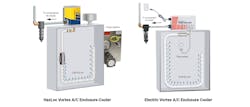Reliable Protection of Electronics in Ordinary and Hazardous Locations
There's no dispute that power densities have increased as electrical and electronic enclosure volumes have gotten smaller. Packing components more densely reduces the circuit size and increases speed but leaves little room for heat dissipation.
Because many industries, including manufacturing, food, chemical, water and wastewater processing, oil refining & petrochemical processing, and others, have become more dependent on sophisticated microprocessors, PLCs and VFDs, the need for proper heat dissipation has become crucial to keep controls protected.
Tightly packed enclosures and panels restrict airflow, resulting in rapidly rising internal temperatures, thermal runaway, and increasing control failures. Thermal testing has proven that natural convection cooling is not adequate for today’s smaller, high-power-density enclosures. Heat dissipation by forced convection (fan cooling) is the most frequently used method of cooling. Forced air cooling systems can provide heat transfer rates that are ten times greater than those achievable with natural convection and radiation, but even those rates are not adequate to cool electronic components in many plant environments, where ambient temperatures can often exceed 90°F (32°C).
To reduce enclosure temperatures and prevent failure of high-density controls, the internal enclosure temperature must be lowered to below room temperature.
Research by control system manufacturers has shown that for each 18°F (10°C) increase in temperature, online production shutdowns occur twice as often, increasing the failure rate of electronics by 40%. Most manufacturers of electronic components specify maximum operating conditions of 104°F (40°C) and 90% humidity for proper operation.
